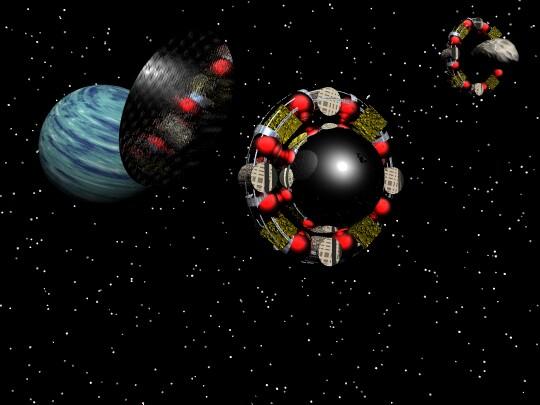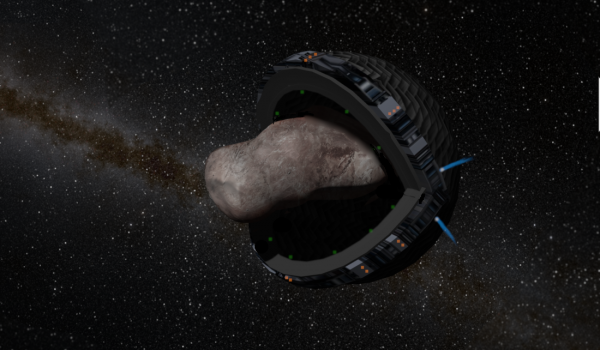BY LETTER
Asteroid Mining, Belt Mining
Technology > Application > Manufacturing
Technology > Application > Materials Technology
Culture and Society > Economics > Occupations, Avocations, and Work
Technology > Application > Materials Technology
Culture and Society > Economics > Occupations, Avocations, and Work
 Image from Todd Drashner |
The process of extracting useful minerals and other substances from asteroids.
Because of their small and easily manageable size, individual asteroids are very valuable. They have no gravity wells, making it relatively easy to move materials to habitat constructions in orbit. Even a small asteroid of a few hundred meters diameter can contain billions of tons of raw material. For this reason, individual prospectors (the so called belters) are willing to gamble life-savings against the cost of relativistic transport, mining rights, and so on, and quite a few do make it rich. Both small and large development corporations are also very keen to get their hands on asteroids. Many asteroids, most particularly nickel-iron rocks, contain varying amounts minerals: platinum, iridium, and sometimes radioactives, while carbonaceous chondrites are prized for being a rich source of volatiles and very occasionally fullerenes and amino acids). Water ice and ammonia are also very useful.
The main difficulties facing an asteroid miner include
- A lack of atmosphere for aerobraking; landing on Earth is made easier because of this useful deceleration aid.
- Minimal Oberth Effect making it expensive in delta-vee to decelerate into orbit round an asteroid,
- Irregular shape, making any orbit around an asteroid chaotic and potentially dangerous ( try plotting a close orbit around Kleopatra without hitting one or other of the protuding ends).
- Rapid rotation- for asteroids smaller than 100m the rotation may be fast enough that you could be thrown off the surface.
- Tumbling- many asteroids probably rotate around more than one axis, which also makes it difficult to land.
 Image from Steve Bowers | |
| A Pacman miner manoeuvring around an asteroid, after matching its rotation. The spherical bag will envelop the object and will become an enclosed environment allowing mining activities to be carried out with minimal losses | |
 Image from Steve Bowers | |
| Neumann vecs replicating near Dactyl. Many von Neumann self-replicating systems replicate by producing miniature copies of themselves which then grow larger over time | |
Occasionally an asteroid or asteroid belt will be discovered with an unusual configuration that makes it valuable for scientific or even aesthetic purposes. Even more rare, the hulk of an ancient ship or a neumann may be recovered, often centuries or millenia old, drifting in a belt. The salvage rights of such a find can make a belter rich for a life. Rarest and most prized of all are alien artifacts, although the possibility of such a find is more a part of myth and legend than pragmatic reality.
Related Articles
- Asteroid
- Carbonaceous type asteroid
- Centaurian Type Asteroid
- Ceres - The Early Years
- Gravity Tug
- Metallic type Asteroid
- Mining
- Oortean Type Asteroid
- Pacman Miner
- Planetesimal - Text by M. Alan Kazlev
One of the small bodies in a solar nebula, from which protoplanets may form. They usually range from micrometers to kilometers in diameter. On the larger scale, planetesimals shade into asteroidal class planetary type bodies. - Planetoid Class
- Silicaceous Type Asteroid
- Trojan Asteroids - Text by M. Alan Kazlev
Asteroids caught near the Lagrangian points in a planet's orbit, 60° ahead of and 60° behind the planet. The original Trojans were connected to Jupiter's orbit, but the term is used to designate asteroids or other similar bodies in a relation to any large planet. - Vesta
- Vestian Type Planetoid
- von Neumann Self-Replicating Systems
- Vulcanian Type Asteroid
Appears in Topics
Development Notes
Text by M. Alan Kazlev, additional comments by Steve Bowers
Initially published on 08 October 2001.
Initially published on 08 October 2001.






